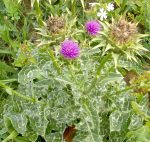 Known by many names including holy thistle, St. Mary’s thistle, and our Lady’s thistle, this annual or biennial is a member of the aster family, Asteraceae, that also includes daisy, sunflower, and lettuce. It is native to the Mediterranean area where it grows in shrubland, woodland, mountains, and deserts. Plants grow 12-79″ tall and have a deep taproot and fleshy grooved stems which may be hollow and/or covered with soft hairs. The shiny green leaves form a basal rosette and are oblong to lanceolate, 6-24″ long, and pinnately lobed with conspicuous white veins and spiny margins. The red-purple flowerheads are 1.5-5″ across and appear from late spring to summer. Each flowerhead is surrounded by hairless, triangular bracts that have spine-edged appendages and a stout yellow spine on its tip. The fruit is a black achene with a large white pappus. Photo Credit Wikipedia
Known by many names including holy thistle, St. Mary’s thistle, and our Lady’s thistle, this annual or biennial is a member of the aster family, Asteraceae, that also includes daisy, sunflower, and lettuce. It is native to the Mediterranean area where it grows in shrubland, woodland, mountains, and deserts. Plants grow 12-79″ tall and have a deep taproot and fleshy grooved stems which may be hollow and/or covered with soft hairs. The shiny green leaves form a basal rosette and are oblong to lanceolate, 6-24″ long, and pinnately lobed with conspicuous white veins and spiny margins. The red-purple flowerheads are 1.5-5″ across and appear from late spring to summer. Each flowerhead is surrounded by hairless, triangular bracts that have spine-edged appendages and a stout yellow spine on its tip. The fruit is a black achene with a large white pappus. Photo Credit Wikipedia
The Hebrew word dardar meaning prickly plant and the Greek word tribolos meaning a prickly (water) plant probably refers to a thistle. The specific thistle intended, however, is difficult to determine since at least 125 thistles grow in the Holy Land. The most probable plants intended are true star thistle (Centaurea calcitrapa), berian century (Centaurea iberica), dwarf century (Centaurea verutum), and milk thistle (Silybum marianum.) The problem is further complicated by the fact that other words in Hebrew and Greek refer to thorns, briars, and other prickly plants and authorities do not agree on the identification of the specific plants so overlap occurs.
Genesis 3: 18 (NKJV) God gives his curse upon man after Adam and Eve eat the forbidden fruit.
“Both thorns and thistles it shall bring forth for you, And you shall eat the herb of the field.”
II Kings 14:9 Jehoash king of Israel uses a story to suggest to king Amaziah that he be happy with his pervious victory over Edom but then to stay home.
“And Jehoash king of Israel sent to Amaziah king of Judah, saying, “The thistle that was in Lebanon sent to the cedar that was in Lebanon, saying, ‘Give your daughter to my son as wife’; and a wild beast that was in Lebanon passed by and trampled the thistle.”
II Chronicles 25:18 (NKJV) See II Kings 14:9 above
“And Joash king of Israel sent to Amaziah king of Judah, saying, “The thistle that was in Lebanon sent to the cedar that was in Lebanon, saying, ‘Give your daughter to my son as wife’; and a wild beast that was in Lebanon passed by and trampled the thistle.”
Hosea 10:8 (NKJV) The consequences of pagan worship are described.
” Also the high places of Aven, the sin of Israel, Shall be destroyed. The thorn and thistle shall grow on their altars; They shall say to the mountains, “Cover us!” And to the hills, “Fall on us!”
Mathew 7:16 (NKJV) In the conclusion of the Sermon on the Mount, Jesus warn about the dangers of false prophets.
“You will know them by their fruits. Do men gather grapes from thorn bushes or figs from thistles?”
Milk thistle likes full sun, and fertile, dry, well-drained soil in USDA Hardiness Zones 5-9. It has no significant pests or diseases and is propagated by seed. Plants have been grown since ancient times as a medicinal herb and used to treat several problems including liver diseases. Although a possible choice for a Bible or Marian garden the plant is generally considered an invasive weed rather than an ornamental.
The genus name, Silybum, is from the Greek word silybon that referred to some thistle-like plant. The specific epithet, marianum, honors the Virgin Mary and the legend that the leaf coloration was caused by the Virgin’s Mary’s milk as it ran down the leaves.